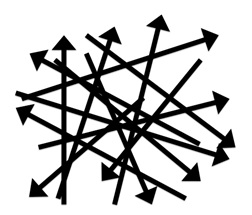 In 1989, after four years of what could be called ala carte improvement, my factory was introduced to policy deployment by Deming Prize winner, Ryuji Fukuda. Tossing a dozen Delta Airlines swizzle sticks on the glass of an overhead projector, Dr. Fukuda asked our team. “Does your plan look like this?” The shadow of the swizzle sticks pointing every which way created an impression.
In 1989, after four years of what could be called ala carte improvement, my factory was introduced to policy deployment by Deming Prize winner, Ryuji Fukuda. Tossing a dozen Delta Airlines swizzle sticks on the glass of an overhead projector, Dr. Fukuda asked our team. “Does your plan look like this?” The shadow of the swizzle sticks pointing every which way created an impression.
In truth we had many plans – too many plans: There was a quality system to be installed, and a new computer system, and there were layout changes on the factory floor and in the office. There were new product plans and plans for new resources to build them. And finally there were Lean type initiatives to shorten lead-time and reduce cost. I used to joke, “We’re drowning in opportunities. The problem is deciding what to do first.”
Dr. Fukuda’s projection however, suggested a bigger problem: Not only were there too many improvement projects vying for scarce resources, but there was a likelihood that without a unifying direction and method for alignment, certain projects would work at cross-purposes to others. Our discovery from the one-week workshop was that while each department thought it had clear marching orders, when the various plans were overlaid, they resembled Dr. Fukuda’s swizzle sticks.
Today, I see a similar problem almost everywhere I go. Recently I gave a homework assignment to a client to list all key improvements on a single page. Two weeks later they sheepishly handed me a sheet printed in six point type. “It’s the only way we could fit them on the page,” they declared. The priorities were broken out by department.
“Why so many?” I asked. After some discussion, two chief reasons for the volume emerged:
- Their quality system required them to identify areas annually for quality improvement. Owing to insufficient resources, few of these priorities could actually be addressed soon, but it was sufficient that they be identified. Many had been carried over from year to year.
- Managers each received many additional objectives relating to cost or delivery. Like the departments they managed, the managers themselves were infinitely loaded down -- drowning in opportunities.
Taking a page from Dr. Fukuda, I asked, “How do you know all of these priorities are aligned?”
“We don’t,” a manager quipped, ‘this is the first time we’ve seen them all together on one page.”
Another manager noted that indeed some of the various projects did conflict. Some cost cutting projects in department A, for example, would have a negative impact on quality or delivery priorities in a downstream function. And everyone agreed that there were more priorities than could possibly be addressed in a year. There were too many goals and too few means. “We work on the hot ones,” one manager added.
“Too much manager-work-in-process,”, I replied, “like trying to fit 10 pounds of potatoes in a five pound bag.”
“More like a hundred pounds,” an engineer exclaimed, “I feel like I’m spending 5% of my time on twenty projects, and almost nothing gets done.”
“How do we get out of this mess?” a top manager interjected.
I replied to her, “My own experience is that policy deployment isn’t an overnight success. But it starts with the question you just asked. It’s a new way of thinking that challenges the same mindsets as on the shop floor: push production, high inventory and local efficiency. So let’s start by agreeing on what’s most important to the customer and then aligning improvement projects regardless of department to the customer need. Then lets agree to limit the manager-work-in-process to enable these projects to flow.”
“But how do we know what’s most important to work on?, the top manager persisted.
I had asked Dr. Fukuda the very same question in 1989. So I responded to her with the same answer Dr. Fukuda gave me: “You’re the manager!”
Are you drowning in opportunities? Let me hear from you.
O.L.D. (More on this topic in a later post.)
BTW. Don’t miss upcoming podcasts from presenters who will be at the October 5-6 Northeast Shingo Conference.

